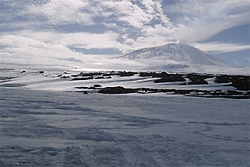 One of the rover M'RAJEs final flights was
select a photo: enlarge photo in the shallow waters off Cape Evans, the location of a historic hut used by Robert F. Scott. Shipping and assembling some scientific instruments in Antarctica can cost millions of dollars, thanks in part to the logistics needed to get materials and personnel to the southernmost continent on Earth. But this year, a relatively meager $5,000 investment returned a wealth of experience for students at a California High School and the research team with whom they are working at McMurdo Station, the National Science Foundation’s logistics hub in Antarctica. Using “off-the-shelf” materials and working with graduate students and technicians from marine biologist Gretchen Hofmann’s laboratory at the University of California, Santa Barbara (UCSB), two female graduates of Cabrillo High School in Lompoc, Calif. built an underwater, camera-equipped “rover” that appears to be able to meet the challenges of the harshest environments on Earth. M’RAJE, (pronounced “mirage”) as the submersible rig has been dubbed (from the first initials of its creators), also is providing Hofmann and her team with an extra set of eyes to observe fish in their natural environments, which frequently are waters covered by many meters of ice. Hofmann studies the environmental genomics of Antarctic fishes and their response to variations in water temperatures such as might occur in a climate change scenario. She also takes very seriously the NSF priority of melding research and education. M’RAJE was built by Ryan Garner and Amanda Wilson, at the time both high-school seniors at Cabrillo. They worked closely with graduate students Jessica Dutton, Mackenzie Zippay, and Elizabeth Hoaglund in Hofmann’s lab to turn the design into a workable prototype. “I really like how Gretchen found these girls and emphasized the ‘women in science’ dimension of the project,” noted Dutton, who acted as a liaison between Hofmann’s laboratory and the rover team. As juniors, both Garner and Wilson were members of a team at Cabrillo that competed and placed highly in the Marine Advanced Technology Education (MATE) Center Remotely Operated Vehicle (ROV) design competition in 2005. Working with Ali Whitmer, the director of education at UCSB’s Marine Science Institute and Robert Ranard and Shirley Pillus who coached the winning 2005, team, Hofmann encouraged Garner and Wilson to design a rover that was better adapted to polar waters. “We wanted it to be specifically designed to do research in Antarctica,” said Dutton. “We knew the design would have to take into account things like how a big a hole we are able to drill in the ice” to provide access to the ocean. Although scuba divers usually assist Hofmann’s team in scouting out the underwater landscape, a successful rover design would compliment the work that human divers can do. The rover, for example, has a maximum tether length of 100 feet, which allows it to operate at the outer limits of safe diving. “We’ve never really been able, ourselves, to look at the habitat down there,” said Dutton. “But we can take a rover out as a team and operate it independently.” M’RAJE made roughly ten successful dives this Antarctic research season, between October and December. |



For USAP Participants |
For The Public |
For Researchers and EducatorsContact UsU.S. National Science FoundationOffice of Polar Programs Geosciences Directorate 2415 Eisenhower Avenue, Suite W7100 Alexandria, VA 22314 Sign up for the NSF Office of Polar Programs newsletter and events. Feedback Form |

